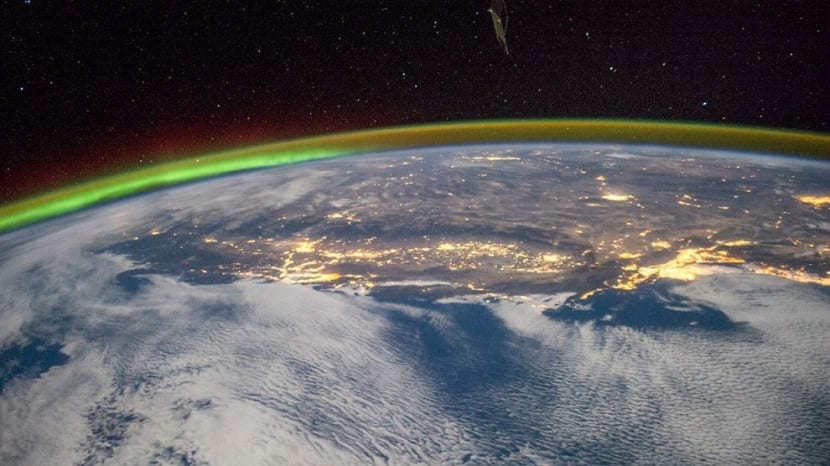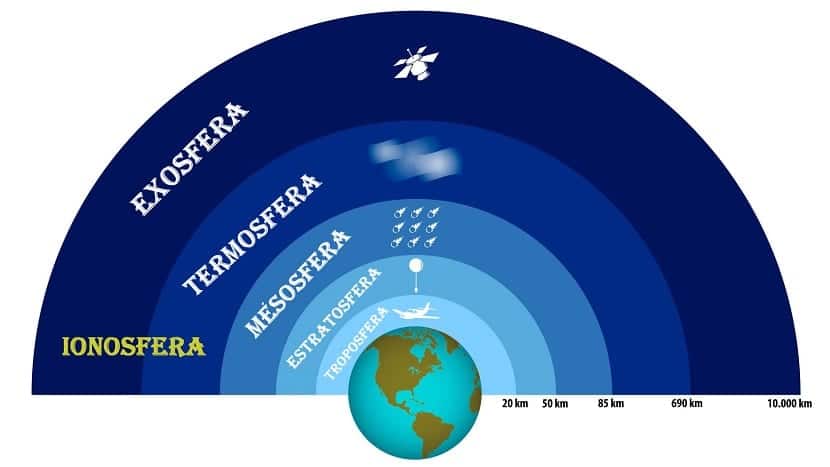
One of the layers of the atmosphere that protects us is the ionosphere. It is a region that contains a large number of atoms and molecules that are charged with electricity. These charged particles are created thanks to radiation that comes from outer space, mainly from our star the Sun. This radiation hits the neutral atoms and air molecules in the atmosphere and ends up charging them with electricity. The ionosphere is of great importance for humans and, therefore, we are going to dedicate this entire post to it.
We are going to explain everything you need to know about the characteristics, operation and importance of the ionosphere.
Key features

While the Sun is shining continuously, during its activity it is generating a large amount of electromagnetic radiation. This radiation falls on the layers of our planet, charging the atoms and molecules with electricity. Once all the particles are charged, a layer forms that we call the ionosphere. This layer is located between the mesosphere, the thermosphere and the exosphere.
More or less you can see that it begins at a height of about 50 km above the earth's surface. Although it starts at this point, where it becomes more complete and important is above 80 km. In the regions that we are in the upper parts of the ionosphere we can see hundreds of kilometers above the surface that extend tens of thousands of kilometers into space is what we call the magnetosphere. The magnetosphere is the layer of the atmosphere that we call this way because of its behavior due to terrestrial magnetic field and the action of the Sun on him.
The ionosphere and the magnetosphere are related by the charges of the particles. One has electrical charges and the other has magnetic charges.
Layers of the ionosphere

As we have mentioned before, although the ionosphere begins at 50 km, it has different layers depending on the concentration and composition of the ions that form it. Previously, the ionosphere was thought to be made up of several different layers that were identified by the letters D, E, and F. The F layer was divided into two more detailed regions which were F1 and F2. Today, more knowledge is available of the ionosphere thanks to the development of technology and it is known that these layers are not very different. However, in order not to make people dizzy, the original scheme that was had in the beginning is maintained.
We are going to analyze part by part the different layers of the ionosphere to see in detail their composition and importance.
Region D
It is the lowest part of the entire ionosphere. It reaches altitudes of between 70 and 90 km. The D region has different characteristics from the E and F regions. This is because its free electrons disappear almost completely during the night. They tend to disappear as they combine with oxygen ions to form oxygen molecules that are electrically neutral.
Region E
This is the layer also known as Kennekky-Heaviside. This name has been given in honor of the American engineer Arthur E. Kennelly and the English physicist Oliver Heaviside. This layer extends more or less from 90 km, where layer D ends up to 160 km. It has a clear difference with the D region and is that the ionization remains throughout the night. It should be mentioned that it is also quite reduced.
Region F
It has an approximate altitude from 160 km to the end. It is the part that has the highest concentration of free electrons since it is the closest to the sun. Therefore, it perceives more radiation. Its degree of ionization does not have much change during the night, since there is a change in the distribution of the ions. During the day we can see two layers: a smaller layer that is known as F1 that is higher up, and another highly ionized dominant layer that is known as F2. During the night both are fused at the level of the F2 layer, which is known as Appleton.
Role and importance of the ionosphere

For many, having a layer of the atmosphere that is electrically charged may not mean anything. However, the ionosphere is of great importance for the development of humanity. For example, thanks to this layer we can propagate radio waves to different places on the planet. We can also send the signals between the satellites and the Earth.
One of the most important factors why the ionosphere is fundamental for humans is because it protects us from dangerous radiation from outer space. Thanks to the ionosphere we can see beautiful natural phenomena such as aurora boreal. It also protects our planet from the celestial rock masses that enter the atmosphere. The thermosphere helps us protect ourselves and regulate the Earth's temperature by absorbing part of the UV radiation and X-rays that are emitted by the Sun. On the other hand, the exosphere is the first line of defense between the planet and the sun's rays. .
The temperatures in this much-needed layer are extremely high. At some points we can find 1.500 degrees Celsius. At this temperature, apart from the fact that it is impossible to live, it would burn every human element that passed by. This is what causes a large part of the meteorites that hit our planet to disintegrate and form shooting stars. And it is that when these rocks come into contact with the ionosphere and the high temperature at which it is found in some points, we find the object becomes somewhat incandescent and surrounded by fire until it ends up disintegrating.
It really is a very necessary layer for human life to develop as we know it today. For this reason, it is important to know her more thoroughly and study her behavior, since we could not live without her.
I hope that with this information you can learn more about the ionosphere.